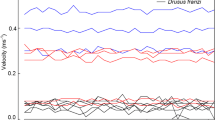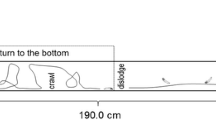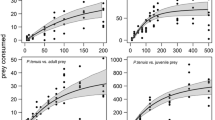Abstract
Diel patterns in mobility and feeding behaviour of the larvae of the stream-dwelling trichopteran Sericostoma personatum larvae were investigated. Larvae fed at night on coarse particulate organic matter (CPOM) at the sediment surface. In the daytime they rested a few cm below the sediment surface, during which time their defaecation activity effected a release of fine particulate organic matter (FPOM) into the sediment. The amount of faeces (mean particle size = 0.1 ± 0.044 mm, x ± SD, n = 500) introduced into the sediment by the larvae, evaluated in two experiments, was 0.4–0.56 mg day−1. This amount did not differ significantly from the organic input resulting from bacterial activity (0.36–0.64 mg day−1). The presence of S. personatum larvae increased the sediment organic content by 42.9 mg (75.8 %) and 59.8 mg (185.6%) AFDW per 16 cm3 sediment over a 90-day period, as compared with control systems containing no larvae.
Similar content being viewed by others
References
Brittain, J. E. & T. J. Eikeland, 1988. Invertebrate drift — a review. Hydrobiologia 166: 77–93.
Elliott, J. M., 1968. The daily activity patterns of mayfly nymphs (Ephemeroptera). J. Zool. 160: 201–221.
Elliott, J. M., 1969. Life history and biology of Sericostoma personatum (Spence) Trichoptera. Oikos 20: 110–118.
Elliott, J. M., 1970. The daily activity patterns of caddis fly larvae (Trichoptera). J. Zool. 160: 279–290.
Elliott, J. M., 1973. The daily activity pattern, drifting and food of the leech Erpobdella octoculata (L.) (Hirudinea: Erpobdellidae) in a Lake District stream. J. anim. Ecol. 42: 449–459.
Gallepp, G., 1974. Dial periodicity in the behaviour of the caddisfly Brachycentropus americanus (Banks). Freshwat. Biol. 4: 193–204.
Gessner, M. O. & J. Schwoerbel, 1989. Leaching kinetics of fresh leaf-litter with implications for the current concept of leaf-processing in streams. Arch. Hydrobiol. 155: 81–90.
Hart, D. D. & V. H. Resh, 1980. Movement patterns and foraging of a stream caddisfly larvae. Can. J. Zool. 58: 1174–1185.
Higler, L. W. G., 1975. Reaction of some caddis larvae (Trichoptera) to different types of substrates in an experimental stream. Freshwat. Biol. 5: 151–158.
Lehmann, U., 1972. Tagesperiodisches Verhalten and Habitatwechsel der Larven von Potamophylax luctuosus (Trichoptera). Oecologia 9: 265–278.
Lush, D. L. & H. B. N. Hynes, 1973. The formation of particles in freshwater leachates of dead leaves. Limnol. Oceanogr. 18: 968–977.
Marxsen, J., 1988a. Evaluation of the importance of bacteria in the carbon flow of a small open grassland stream, the Breitenbach. Arch. Hydrobiol. 111: 339–350.
Marxsen, J., 1988b. Investigations into the number of respiring bacteria in groundwater from sandy and gravelly deposits. Microb. Ecol. 16: 65–72.
Mattingly, R. L., 1987. Resource utilization by the freshwater deposit feeder Ptychoptera townesi (Diptera: Ptychopteridae). Freshwat. Biol. 18: 241–253.
Mattingly, R. L., 1988. Pelletization of sediment by the deposit-feeding invertebrate, Ptychoptera townesi (Diptera: Ptychopteridae). Arch. Hydrobiol. 112: 421–431.
Müller, K., 1982. The colonization cycle of freshwater insects. Oecologia (Berlin) 52: 202–207.
Rennerich, J. & H. Schuhmacher, 1983. Some aspects of the case building behaviour of the burrowing caddis larvae of Sericostoma personatum Kirby & Spence, 1826. Proc. 4th Int. Symp. on Trichoptera, Clemson: 301–305.
Shepard, R. B. & G. W. Minshall, 1984. Role of benthic insect feces in a Rocky Mountain stream: fecal production and support of consumer growth. Holarct. Ecol. 7: 119–127.
Statzner, B., J. A. Gore & V. H. Resh, 1988. Hydraulic stream ecology. Observed patterns and potential applications. J. North Am. Benthol. Soc. 7: 307–360.
Thorne, M. J., 1969. Behaviour of the caddisfly larva Potamophylax stellatus (Curtis) (Trichoptera). Proc. R. Ent. Soc. London, A 44: 91–110.
Thorup, J. & T. M. Iversen, 1974. Ingestion by Sericostoma personatum Spence (Trichoptera, Sericostomatidae). Arch. Hydrobiol. 74: 39–47.
Tolkamp, H. H., 1980. Organism-substrate relationships in lowland streams. Centre for Agricultural Publishing and Documentation, Wageningen, 211 pp.
Wagner, R., 1987. Effects of an artificially silted stream bottom on species composition and biomass of Trichoptera in Breitenbach. Proc. 5th Int. Symp. on Trichoptera Lyon: 349–352.
Wagner, R., 1989. The influence of artificial stream bottom siltation on Ephemeroptera in emergence traps. Arch. Hydrobiol. 115: 71–80.
Wagner, R., 1990. A laboratory study on the life cycle of Sericostoma personatum (Kirby & Spence), and light-dark dependent food consumption. Hydrobiologia 208: 201–212.
Author information
Authors and Affiliations
Rights and permissions
About this article
Cite this article
Wagner, R. The influence of the diel activity pattern of the larvae of Sericostoma personatum (Kirby & Spence) (Trichoptera) on organic matter distribution in stream-bed sediments — a laboratory study. Hydrobiologia 224, 65–70 (1991). https://doi.org/10.1007/BF00006862
Received:
Revised:
Accepted:
Issue Date:
DOI: https://doi.org/10.1007/BF00006862




